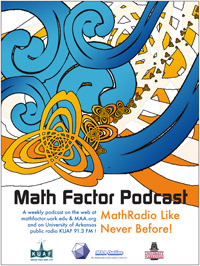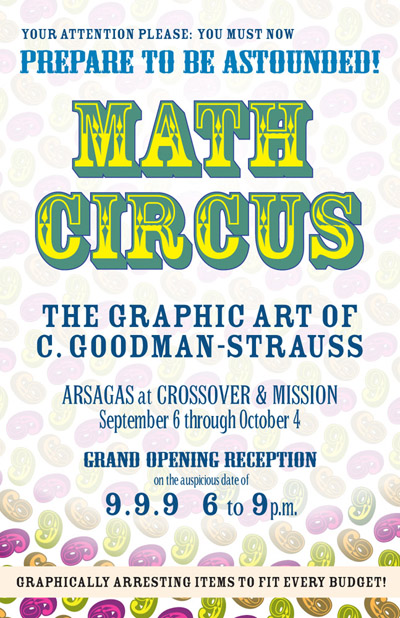October 5, 2009
·
Authors, math puzzles, Yoak
I recently got back in touch with an old friend and puzzler and he reminded me of a puzzle that he once told me about that confounded me for weeks. Faced with a restatement of it, again I couldn’t come up with an answer for the life of me. The mechanism is painfully simple, but there is something about the particulars here that short my mind out.
Combine the four number 1,3,4,and 6 with operators of addition, subtraction, multiplication and division (and parenthesis to indicate order of operation) to yield an expression equal to 24.
I assure you that you can take this in the most straight-forward manner possible. You aren’t mean to smoosh them together to get “13” out of 1 and 3. You aren’t meant to use “1” as a problem number or something of that sort. An answer will look something like this:
(4-1)*3/6
except that is equal to 1.5 . Your expression must equal 24.
I’m interested to hear if this is as difficult for others as it was for me.
Permalink
October 5, 2009
·
The Mathcast
Stephen Morris explains his sneaky clock puzzle and revisits last month’s OLD IDAHO USUAL HERE
Permalink
October 1, 2009
·
answers, guests, math puzzles, Morris, The Mathcast
Hmm. Somehow Stephen Morris pulls off that rarest of Math Factor tricks– leaving Kyle and Chaim at a loss for words, with his sneaky clock puzzle.
Permalink
September 20, 2009
·
math puzzles, Topology and geometry, Yoak
This will be the last of my Lewis Carroll posts. In Pillow Problems, Carroll writes:
Three Points are taken at random on an infinite Plane. Find the chance of their being the vertices of an obtuse-angled Triangle.
Note: An obtuse-angled triangle is one that has an angle measuring more than 90 degrees.
Permalink
September 17, 2009
·
Favorites, guests, math puzzles, Morris, The Mathcast
Kyle and Chaim get into trouble with their wives and Mathfactor correspondent, Stephen Morris, discusses the Kate Bush Conjecture and And The Clocks Struck Thirteen
Oh by the way, would you like a cool Math Factor Poster? Click on this to download:

Permalink
September 11, 2009
·
math puzzles, The Mathcast, Yoak
This puzzle is taken from a letter Carroll wrote to a 14-year-old girl named Helen Fielden. Carroll writes:
I don’t know if you’re fond of puzzles, or not. If you are, try this. If not, never mind. A gentlemen (a nobleman let us say, to make it more interesting) had a sitting-room with only one window in it — a square window, 3 feet high and 3 feet wide. Now, he had weak eyes, and the window gave too much light, so (don’t you like “so” in a story?) he sent for the builder, and told hm to alter it, so as to give half the light. Only, he was to keep it square — he was to keep it 3 feet high — and he was to keep it 3 feet wide. How did he do it? Remember, he wasn’t allowed to use curtains, or shutters, or coloured glass, or anything of that sort.
Permalink
September 8, 2009
·
The Mathcast
We finally get back in the studio with a new puzzle after a long and sleepy summer… meanwhile, here comes The Math Circus!

Permalink
August 29, 2009
·
math puzzles, Morris, The Mathcast
 How does an amatuer mathematician collaborate with a professional? Through the internet of course!
How does an amatuer mathematician collaborate with a professional? Through the internet of course!
We do it all the time on Math Factor.
Chaim pointed me at the Macalester Problem of the Week. This led to my making a minor contribution to a published paper. I can’t claim it’s a world changing paper, or that my contribution amounted to much, but I did get my name in print! You can read an extract here. {Just above is a review of a book on symmetry, I’m not sure that is real, one of the authors is called Chaim Goodman-Strauss, clearly a made up name.}
It certainly is a fun paper. Stan Wagon is a bit of a legend, as you’ll see from the picture. I’m campaigning for all cycle paths to be built for square wheeled bicycles!
Can you solve some of these problems?
Read the rest of this entry »
Permalink
August 20, 2009
·
Authors, math puzzles, Yoak
Since my last post, I actually dug up one of my books with Carroll problems. I’ll present this one in Carroll’s own words and add a few notes:
Carroll writes:
Some men sat in a circle, so that each had 2 neighbours; and each had a certain number of shillings. The first had I/ more than the second, who had I/ more than the third, and so on. The first gave I/ to the second, who gave 2/ to the third, and so on, each giving I/ more than he received, as long as possible. There were then 2 neighbors, one of whom had 4 times as much as the other. How many men were there? And how much had the poorest man at first?
Notes:
A ‘/’ is clearly to be read as a shilling and the ‘I’ is to be read as 1. With that, I think the operations is clear. It is also clear that eventually someone will not be able to pass along 1 more shilling than he was passed, given the finite number of shillings in the game. When that state occurs, instead of passing that person retains the shillings he was just passed. We are then told that it is true that someone now holds 4 times as many shillings as one of his neighbors and are asked how many men there are and how many shillings the poorest of the group must have had to start.
Permalink
August 14, 2009
·
Authors, math puzzles, Yoak
I’ve enjoyed several books by and about Lewis Carroll with puzzles, games and neat observations. I’m going to post a few here. Here’s a simple one with which to get started.
Suppose that I secretly flip a coin and place either a blank or white stone in a bag based on the result. I then put a white stone in the bag for two stones in total. I invite you to pull one stone out and it turns out that it is white. What is the chance that the other stone in the bag is also white?
Permalink




 mathbun.com
mathbun.com